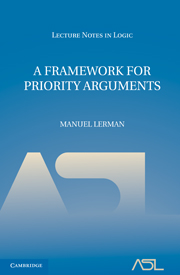Book contents
- Frontmatter
- Contents
- PREFACE
- CHAPTER 1 INTRODUCTION
- CHAPTER 2 SYSTEMS OF TREES OF STRATEGIES
- CHAPTER 3 Σ1 CONSTRUCTIONS
- CHAPTER 4 Δ2 CONSTRUCTIONS
- CHAPTER 5 Π2 CONSTRUCTIONS
- CHAPTER 6 Δ3 CONSTRUCTIONS
- CHAPTER 7 Σ3 CONSTRUCTIONS
- CHAPTER 8 PATHS AND LINKS
- CHAPTER 9 BACKTRACKING
- CHAPTER 10 HIGHER-LEVEL CONSTRUCTIONS
- CHAPTER 11 INFINITE SYSTEMS OF TREES
- REFERENCES
CHAPTER 1 - INTRODUCTION
Published online by Cambridge University Press: 04 August 2010
- Frontmatter
- Contents
- PREFACE
- CHAPTER 1 INTRODUCTION
- CHAPTER 2 SYSTEMS OF TREES OF STRATEGIES
- CHAPTER 3 Σ1 CONSTRUCTIONS
- CHAPTER 4 Δ2 CONSTRUCTIONS
- CHAPTER 5 Π2 CONSTRUCTIONS
- CHAPTER 6 Δ3 CONSTRUCTIONS
- CHAPTER 7 Σ3 CONSTRUCTIONS
- CHAPTER 8 PATHS AND LINKS
- CHAPTER 9 BACKTRACKING
- CHAPTER 10 HIGHER-LEVEL CONSTRUCTIONS
- CHAPTER 11 INFINITE SYSTEMS OF TREES
- REFERENCES
Summary
This chapter is devoted to the presentation of basic definitions and notation to be used in this monograph. The definitions fall under three general headings; those related to computable partial functionals and computably enumerable sets, those related to the computably enumerable degrees, and those related to trees.
Computably Enumerable Sets
Let ℕ be the natural numbers, i.e., the set of integers {0, 1, 2, …}. We use interval notation on ℕ; thus [k, m] = {n : k ≤ n ≤ m}. Open interval notation and half-open interval notation is used in a similar fashion. The direct sum of two subsets A and B of ℕ is denoted as A ⊕ B and is defined as {2x : x ∈ A} ∪ {2x + 1 : x ∈ B}. |A| will denote the cardinality of the set A.
If A ⊂ ℕ, m ∈ ℕ, and Φ is a partial functional, then we write Φ(A; m) ↓ if m is in the domain of Φ(A), and Φ(A; m) ↑ otherwise. If Φ and Ψ are partial functionals and A and B are sets, then we write Φ(A) ≃ Ψ(B) if Φ(A) and Ψ(B) are compatible, i.e., for all x, if Φ(A; x) ↓ and Ψ(B; x) ↓, then Φ(A; x) = Ψ(B; x); and we write Φ(A) = Ψ(B) if Φ(A) and Ψ(B) are identical, i.e., Φ(A) and Ψ(B) are compatible and for all x, Φ(A) ↓ iff Ψ(B) ↓.
- Type
- Chapter
- Information
- A Framework for Priority Arguments , pp. 1 - 4Publisher: Cambridge University PressPrint publication year: 2010



